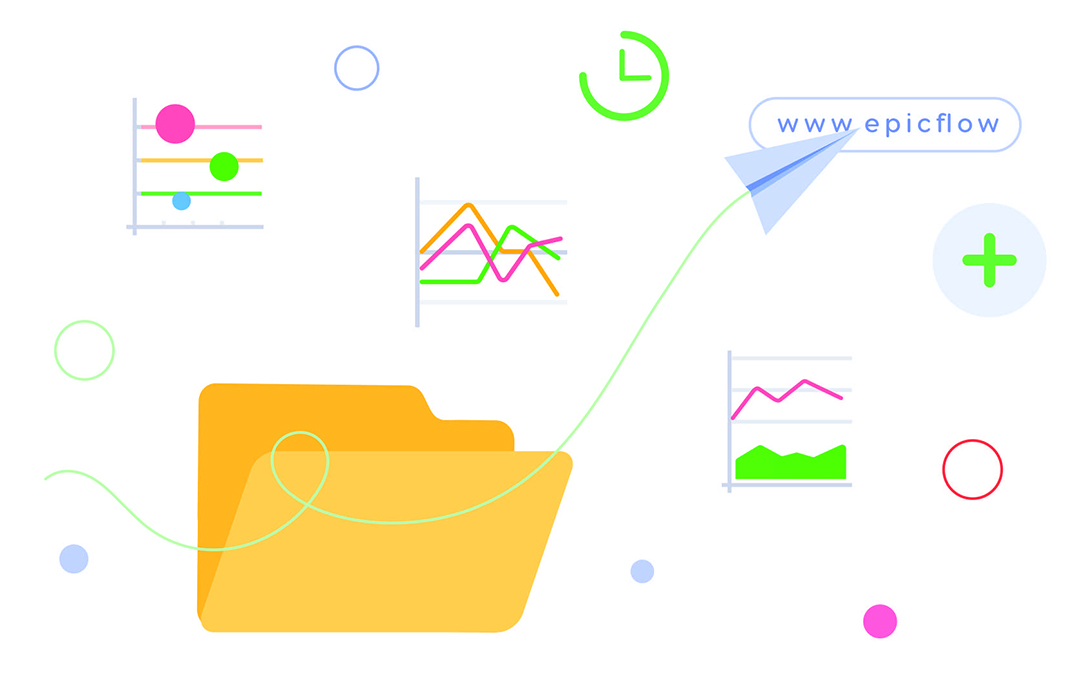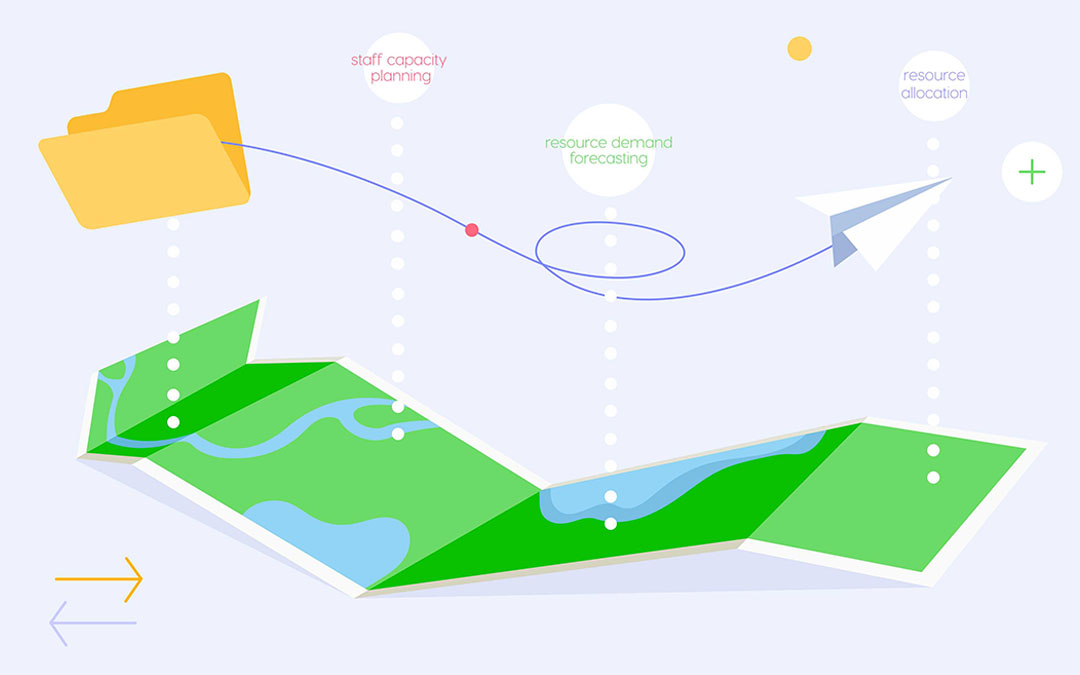Business organizations that run multiple complex projects, experience business growth but have limited resources may require a more sophisticated approach to managing all their projects. In particular, they need to sort all their endeavors in line with the organizational goals and objectives. This is where project portfolio management (PPM) can help.
Read further to learn about more benefits of the PPM, how it differs from traditional program and project management, and how to manage your portfolio of projects in the most efficient way.
What Is Project Portfolio Management?
Before we answer the question “What is project portfolio process?”, let’s define the concept of a project portfolio. It’s a collection of projects or programs whose implementation facilitates achieving a company’s strategic goals and objectives.
“A portfolio is a dataset of projects and activities”.
Jan Hindrik Knot, Interim Programme Manager and Consultant.
Project portfolio management (PPM) is the process of selecting, prioritizing, and administering the portfolio of a company’s projects [1]. In addition to aligning them with business objectives, PPM takes into account a company’s capacity to complete them, so it also involves assessing resources available at the company (human, material, and financial) and assigning them to the projects that are most significant for an organization at the moment. The result? Each project in a company contributes to achieving its goals and objectives, and available resources are utilized in an optimal way.
Project portfolio process in project management isn’t a must for every business organization. Here are the examples of companies that should implement PPM:
- Growing organizations with active project management activities;
- Companies running interrelated projects in which different departments are involved;
- Organizations that work on complex projects with limited resources and changing priorities;
- Companies that are striving to increase their project management maturity.
So, project portfolio management is required by growing and fast-developing enterprises that seek to prioritize the projects they run and ensure their strategic alignment.
“The primary goal of project portfolio management is preventing resource overload and protecting the entire project portfolio from increased waiting times and low productivity.”
Jan Willem Tromp, a researcher, a multi-project resource management expert, and a co-founder of Epicflow.
The difference between project, program, and portfolio management
To avoid confusion between all these concepts, let’s consider their meaning in more detail.
- According to the PMBOK Guide [2], a project is a temporary endeavor aimed at creating a product, or service, or achieving some other result. The purpose of project management is to guide this endeavor toward successful completion – to deliver it on time, within budget, and in line with customers’ expectations and existing constraints.
- A program embraces a set of projects that have a common value for a company. Program management involves coordination and control over this group of projects, ensuring that the team members perform the right work at the right time.
- Finally, a portfolio is a collection of projects and programs that have common strategic goals and objectives. The purpose of project portfolio management is not only running all of them but allocating resources effectively and ensuring strategic alignment.
Read more: Portfolio Management and Resource Allocation: What Do They Have in Common?
Let’s now review why project portfolio management is so important for enterprises.
The benefits of project portfolio management
- Prioritizing projects running in an organization.
As a result of prioritization, a company can focus on the projects that will deliver maximum value for them for the moment.
- More efficient utilization of the available resources.
Assigning resources to the most significant projects contributes to their more intelligent utilization and the ability to deliver the highest-priority projects on time and within budget.
- Reducing risks.
The PPM processes involve the analysis of a company’s capacity to complete projects and in such a way reduces the risks of starting the unfeasible ones, which will negatively affect the other projects in the portfolio.
- Improved ROI.
Aligning every project with a company’s strategic goals and objectives, reducing risks, and efficient utilization of the available resources contribute to increasing the return on investment of every project in the portfolio and increasing a company’s profitability.
- Better project and business outcomes.
Focusing on projects that deliver maximum value to an organization, intelligent allocation of a company’s resources, and minimized risks contribute to achieving better project and business outcomes.
Now that you understand the significance of project portfolio management for an organization, it’s time to examine the main project portfolio management process steps
Read more: Top 15 Portfolio Management Tools for Your Business in 2025
The Fundamental Steps of the Project Portfolio Management Process
Here are project portfolio process 8 steps that are indispensable for effective project portfolio management.
Step 1. Identify a company’s business objectives.
To be able to work further with the project portfolio, you should clearly understand what a company is striving to achieve.
Step 2. Determine current and upcoming projects.
Without insight into all of these projects, you won’t be able to come up with the right strategy for the portfolio.
Step 3. Identify each project’s impact.
To be able to include the projects in the portfolio, you should understand what impact their delivery will have on a company’s business strategy.
Step 4. Analyze projects’ feasibility.
Apart from the project’s impact, it’s important to be sure of its feasibility. So, at this stage, you should perform a feasibility study and capacity planning to be sure that an organization has enough resources to deliver this project successfully.
Step 5. Prioritize projects.
Having an idea of a company’s strategic goals and objectives along with the projects’ feasibility, and impact, you can set the right priorities across the project portfolio.
Step 6. Allocate resources.
When assigning resources to the projects of the portfolio, you should keep in mind the priorities as well as the resources’ availability and capacity. When it comes to human resources, it’s critically important to keep their workload balanced – otherwise, they won’t be productive and can become bottlenecks for the project flow.
Step 7. Keep track of the state of the project portfolio.
Effective project portfolio management is impossible without regular monitoring and control. It allows you to timely spot any issues and take necessary measures to fix them so that they won’t affect other projects in the portfolio.
Step 8. Manage changes.
In the present-day dynamic business environment, companies have to be flexible and adjust their strategy and goals in response to external changes. A project management office should monitor the changes and adjust the project portfolio strategy accordingly.
Understanding the key steps in project portfolio process will help you align initiatives with business strategy, optimizing resource allocation, and maximizing ROI.
Participants of the Project Portfolio Management Process
The project portfolio management process is impossible without the participation of stakeholders from multiple levels of the organization. What are their roles and contributions?
1. Executive leadership.
The members of executive leadership are CEO, CIO, CFO, and other participants of senior leadership. They define strategic goals, approve project portfolios, allocate budgets, and ensure the project portfolio’s alignment with organizational goals. Also, executive leadership should select projects that will deliver the highest business value. Therefore, their involvement ensures that projects run by an organization support long-term growth and organizational priorities.
2. Project management office (PMO) and Portfolio Management Office (PPMO).
PMOs oversee the orchestration and performance of every project in the portfolio, establish standards and frameworks. They also create reporting structures, adopt PMO tools, and ensure compliance with organizational methodologies. PMO contributes to consistency in portfolio execution and efficient utilization of resources across the entire portfolio.
In recent years, we’ve seen the rise of a portfolio management office. They operate on a more strategic level than PMOs. PfMO mostly deals with strategic alignment, project prioritization, and supports making investment decisions.
3. Project portfolio managers.
Project portfolio managers are responsible for portfolio alignment with organization’s priorities. They evaluate and prioritize projects within portfolios, balance resources, keep track of the entire portfolio state, and suggest improvements to leadership. They make their decisions based on data analysis, performance metrics, capacity analysis, and potential ROI. Finally, they unite strategic leadership and operational project teams.
4. Program and project managers.
They are responsible for daily operations and project performance. For example, they manage individual projects and report project status, potential risks, and alignment with strategic goals. They also collaborate with resource managers to make sure that team capacity is enough to meet project deadlines.
5. Resource managers.
Resource managers allocate and administer human resources across multiple projects and ensure that are neither overallocated or underutilized. At the same time, resource management tasks are usually done by department leads, team leaders, or dedicated resource managers. They distribute resources across the portfolio, plan capacity, and ensure its alignment with portfolio needs. The role of resource managers in effective project portfolio management is significant for maintaining realistic workloads and proper resource distribution across projects.
6. Functional managers.
Functional managers are heads of various departments, e.g., IT, R&D, marketing, etc. They help prioritize projects depending on their impact on the business needs. They also contribute to domain-specific knowledge, assess resource availability, and support cross-functional collaboration.
7. Finance team.
The finance team ensures that each project within the portfolio align with the budget constraints. These participants of the project portfolio process monitor portfolio budgets, track ROI, and ensure the financial feasibility of projects and programs in the portfolio. Their financial insight ensures that investments are optimized and support overall profitability.
But what should you do to ensure that your project portfolio management process flow is effective? Let’s now consider some best practices .
Best Practices For Project Portfolio Management Process
An effective PPM process flow involves detailed planning, strategic alignment, collaboration with stakeholders, and wise resource management. Here are some best practices in more detail.
Tip 1. Align projects with strategic goals.
How can you ensure the effectiveness of project portfolio management process? The answer is simple: you need to make all projects run by an organization aligned with its strategic objectives. This approach will help you maximize value and supports long-term success.
To ensure proper strategic alignment, you should follow these steps:
- Define objectives: All departments in the organization must know and understand the company’s strategic goals and align their actions with them.
- Prioritize projects based on their value: Use specific tools to assess projects’ strategic alignment, possible risks, and ROI potential.
- Review alignment regularly: Strategic priorities may shift under the impact of different factors, so it’s reasonable to check project’s alignment from time to time.
Tip 2. Establish proper management and standardization.
It’s critically important that your organization’s management establish the right accountability, consistency, and decision-making within the whole portfolio lifecycle. Therefore, you should create a PPM governance structure. What tasks will it be responsible for? It would control project selection, prioritization, and resource allocation. Also, it’s a good idea to ensure that all stakeholders (project managers, resource managers, executives) understand their responsibilities in the PPM process. Finally, you should standardize all processes related to PPM: project approval, its execution and closure.
Tip 3. Manage available resources effectively.
What are the biggest constraints of multi-project and portfolio management? Of course, they are resource constraints. But the thing is that wise resource management will facilitate achieving desired outcomes without hiring more people. To manage resources effectively across project portfolio, you should have database with all resources of the organization with the information on their availability, capacity, skills, location, and other essential parameters. The second component of effective resource management is resource capacity planning: bridging the resource demand with available capacity to prevent overallocation and bottlenecks. Regular tracking of resource performance will allow managers to detect bottlenecks early on, before they affect the project level, and change the situation before it escalates.
Tip 4. Prioritize projects across the portfolio.
When budgets and resources are limited, prioritzation is the key to maximize the value of the project portfolio. To prioritize projects within the project portfolio effectively, you should first of all establish prioritization criteria (e.g., business impact, urgency, risks, strategic alignment, etc.). It’s critically important to review priorities regularly, as some criteria may change under the impact of various circumstances. With project prioritization, companies will have an opportunity to deliver the most valuable projects without adding extra resources.
Tip 5. Manage risks.
Why is this so essential for project portfolio management? Because proper risk management ensures portfolio resilience and successful outcomes. To make the risk management process effective across the portfolio, you should not only assess risks in individual projects but also identify threats that may impact the entire portfolio. After that, it’s essential to prepare risk response plans for the threats with the most sever impact. Finally, effective risk management is impossible without regular monitoring and adjustment of the risk management strategy.
Tip 6. Monitor portfolio performance.
Tracking performance allows managers to assess the state of the entire portfolio and make more effective decisions. Use key performance indicators (e.g., resource utilization, remaining buffer, etc.) to assess the effectiveness of the PPM process. For better results, use dashboards and reports provided by specific portfolio management tools.They will help you visualize the progress across the portfolio. Finally, conduct regular portfolio reviews with stakeholders to analyze progress, risks, and opportunities.
“One of the main prerequisites for the success of multiple projects with a shared resource pool is being sure your available resource can handle the demand coming from the planned projects and will be able to handle it in the future without being overloaded”.
Jan Willem Tromp, a researcher, a multi-project resource management expert, and a co-founder of Epicflow.
Read more: Tracking Performance: Switching from Project to Resource Level
Finally, one of the most important prerequisites for successful project portfolio management is adopting the right PPM software. Read the next section to learn more about its capabilities.
Project Portfolio Management Software: How PPM Tools Support the Project Portfolio Management Process

Applying PPM software is a must for the successful management of project portfolios. The PPM process involves dealing with lots of projects and a large number of resources involved in them. So, without a robust PPM solution, it will easily turn into chaos. Let’s review how this software’s capabilities can contribute to successful project portfolio management through the example of Epicflow. It’s AI-powered multi-project resource management software with PPM functionality and a focus on achieving resource efficiency, setting the right priorities, making data-driven decisions, and preventing roadblocks in the workflow.
This is how Epicflow’s features enable successful project portfolio management.
Planning resources’ capacity.
With Epicflow’s capacity planning tool, you can gain insight into team members’ future workloads and capacity to understand whether your resources will be able to cope with an upcoming project without being overloaded.
Analyzing a project’s feasibility.
You can use Epicflow’s scenario planning software mode to run simulations and test different changes to the project portfolio. For example, you can add a new project to the simulated environment and see how it will affect other projects in the portfolio: will you be able to deliver all of them on time? Does it require hiring extra employees? Will reassigning resources help? And so on.
Detecting and addressing bottlenecks.
Bottlenecks are resources that are overloaded and cannot cope with their work. According to Epicflow’s philosophy, bottlenecks have the most negative impact on the project portfolio. Very often, they remain unnoticed and negatively affect other resources and projects in the portfolio until it’s too late to change the situation. Epicflow has several features to ensure bottleneck-free project flow.
- Its workload management software makes it possible to analyze resources’ historical performance and identify what bottlenecks hamper the flow.
- Epicflow’s Load Analysis will help you determine the causes of the existing bottlenecks – what projects and tasks overload your resources.
- Epicflow’s Project Staggering feature helps prevent future bottlenecks: it analyzes current projects in the portfolio along with resources’ capacity and suggests time until which it’s better to postpone lower-priority projects. Such an approach will help you avoid bottlenecks in the highest-priority projects and deliver them successfully.
Most effective resource allocation
Epicflow facilitates assigning the right resources to project tasks: it analyzes each team member’s skills, capacity, and availability, and suggests a perfectly matching employee to complete a task. As a result, it increases team members’ productivity and helps prevent bottlenecks caused by assigning too much work to one person.
Providing visibility into the state of every project and the entire project portfolio.
To be able to monitor and control the state of the project portfolio, Epicflow has a number of features that help you assess it at a glance. For example, Bubble Graph, which is an improved version of the Fever Chart, presents all projects in the portfolio in the form of bubbles of different colors depending on their state and shows the projects’ state in relation to the remaining time and budget.
This was just a part of Epicflow’s functionality that enables effective portfolio management and successful delivery of all its projects. Contact our experts to find out more about how it can drive your business success.
Conclusions
If your organization is managing multiple projects and striving to succeed and gain a competitive advantage, effective project portfolio management is the key. But how can you ensure the effectiveness of the project portfolio management process? You should align projects with the business strategy, prioritize projects accordingly, perform resource capacity planning, effectively manage resources and risks. Also, you will hardly do without regular monitoring of resource performance. Finally, there’s one more “secret ingredient” – the right project portfolio management tools. With these solutions, you’ll be able to plan capacity, detect and address bottlenecks, make informed decisions, and achieve desired outcomes much faster.
References
- What Is Portfolio Management? Association of Project Managers. Retrieved from: https://www.apm.org.uk/resources/what-is-project-management/what-is-portfolio-management/
- A Guide to the Project Management Body of Knowledge. 5th edition. Retrieved from: https://repository.dinus.ac.id/docs/ajar/PMBOKGuide_5th_Ed.pdf
Frequently Asked Questions
What is portfolio management in project management?
The project portfolio management process involves selecting, prioritizing, and administering the portfolio of a company’s projects. It’s impossible to manage project portfolio without ensuring projects’ strategic alignment, resource management and capacity planning, comprehensive monitoring and control, and effective decision-making. The result? Your organization works on projects that have the highest value for them at the moment.
What are the benefits of project portfolio management?
Effective project portfolio management provides organizations with the following benefits: selecting projects with the highest business value, effective resource utilization, minimized risks, higher ROI, and improved business outcomes.
What is the difference between PMO and PPM?
PMO is a project management office. Its focus is on standardizing project execution and ensuring projects are delivered efficiently. PPM is project portfolio management. It’s focused on selecting, prioritizing, and managing projects to align with business goals and maximize value. PMO ensures projects are done right, PPM ensures the right projects are done.
What are the 8 steps of project portfolio management?
The project portfolio management process includes the following steps. You need to identify a company’s business objectives, determine current and upcoming projects, identify each project’s impact, analyze projects’ feasibility, prioritize projects, allocate resources, keep track of the state of the project portfolio, and manage changes.
What is project portfolio management software?
Project portfolio management software is a tool that supports the PPM process in the multiple ways. For example, it ensures strategic alignment, helps prioritize projects, allocate resources, and perform capacity planning, improves decision-making, and ensures comprehensive portfolio control.







